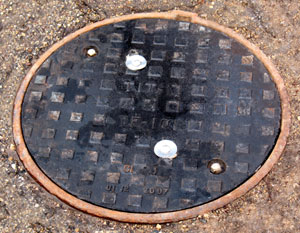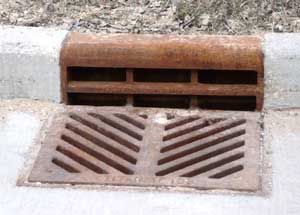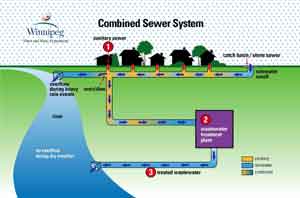Holiday season – View holiday hours for City of Winnipeg facilities and services from December 24 to January 1.
Infrastructure
- Sewer system
- Sewer main renewals
- Septic systems
- Identifying manhole covers and catch basins
Sewer system
Our wastewater collection (sewer) system is made up of:
- combined sewers
- interceptor sewers
- separate sewers
- land drainage systems
- lift stations and diversion structures
- combined and separate sewer areas
Combined sewers
A system of single pipes that collect both wastewater from homes, businesses and industries as well as surface runoff from rainstorms and snow melt.
There are 76 combined sewer outfalls or outlets to the river system.
The older, central region of Winnipeg is served by 1,037 km of combined sewer pipes.
Prior to 1937, the collected sewage and storm runoff flowed directly into the local river system without being treated.
In 1937, an interceptor sewer system was built to carry sewage in the combined sewer system to the North End Sewage Treatment Plant (NEWPCC).
There are 119 kilometers of interceptor sewers in the city that carry sewage to the three treatment plants.
Weirs, or small dams, were installed in all combined sewers near the outlet of the pipe to divert sewage to the interceptor sewer system during dry weather conditions.
In wet weather conditions, flows are higher because runoff enters the system. A higher flow means the wastewater level in the pipe may become higher than the height of the weir. When this happens, combined sewers overflow to the river system.
Combined sewer overflows occur, on average, 22 times during the year.
Separate sewers
 A system of two pipes where one pipe carries wastewater and the other carries land drainage and surface runoff from rainstorms and snow melt.
A system of two pipes where one pipe carries wastewater and the other carries land drainage and surface runoff from rainstorms and snow melt.The role of the separate sewer system is to collect wastewater from homes, businesses and industries and carry it to a water pollution control centre for treatment.
Since the 1960s, new property developments in the city have been serviced by a two-pipe system.
The sewage or sanitary sewer system has about 1,423 km of dedicated pipes that are completely separate from the land drainage system.
Land drainage sewers
- A system of single pipes that carries rainfall and snow melt runoff from urban areas to the river system.
- There are 1,173 km of land drainage sewers in Winnipeg.
 Lift stations and diversion structures
Lift stations and diversion structures
- Because of Winnipeg's relatively flat terrain, it is necessary to pump wastewater using lift stations to the interceptor sewers or to the water pollution control centres.
- The main purpose of a lift station is to raise sewage to a higher level so that it can be moved into a sewer system where it can flow by gravity.
- There are 74 wastewater pumping stations and 10 gravity-based wastewater diversion facilities located throughout the city.
Combined and separate sewer areas
- The combined sewer system services an area of approximately 8,700 hectares or about 31% of the city.
- The separate wastewater and land drainage sewers services an area of approximately 22,300 hectares or about 70% of the city.
To see where combined sewers are in Winnipeg, or if there is any combined sewer overflow activity in your area, visit MyUtilityInfo.
Sewer main renewals
 We replace or repair thousands of meters of older sewer mains each year to:
We replace or repair thousands of meters of older sewer mains each year to:
- reduce sewer backups
- ensure sewer service is available worry free to our customers
- protect the environment
How do we know which sewers to repair or replace?
We have an annual cleaning and inspection program which provides information about the condition of our sewer mains. Sewer pipes in poor condition are put on a list for repair or replacement. After that, they are scheduled each year based on their priority on the list. We also coordinate sewer and water renewals with street renewals as much as possible to avoid digging up new streets.
How many sewers have we inspected?
By 2018, we have inspected approximately 96 per cent of combined sewers, 82 per cent of sanitary sewers, 24 per cent of land drainage sewers and 66 per cent of storm relief sewers.
How much do we spend on the inspection and repair/replacement program?
In 2018, we will spend approximately $18.2 million on our sewer inspection and repair program. Over the past 10 years, we have spent between $12.6 and $18.8 million per year on the program.
Will I be notified if you are going to renew the sewer main on my street?
Yes. We will deliver a printed notice to your home or business a week or so before construction is going to start. The notice will tell you:
- the dates for the project
- lane closures, if any
- changes in services like garbage pick-up and transit, if applicable
- anything you need to do during renewal
- the name of the contractor
- the name and daytime contact information for the project consultant or administrator
- the after hours emergency contact number
How do you coordinate renewals on major streets when access and service to businesses or large customers may be affected by construction?
We communicate with affected customers well in advance of the construction to understand their concerns and minimize the impact on business as much as possible.
How I can find out if the sewer on my street is going to be renewed?
Contact 311.
Your septic system
Septic systems are designed to safely recycle wastewater back into the natural environment. If you don't operate or maintain your septic system properly, it can be dangerous for your family, pose a threat to public health or the environment and affect neighbouring property owners.
A septic system has two parts:

- a septic tank
- a septic field
How does my septic system work?
- The waste separates into sludge, liquid and scum.
- Naturally occurring bacteria break down the sludge and the scum.
- Solids that can't be broken down settle at the bottom and must be pumped out regularly.
- The liquid flows out of the tank into a network of underground pipes that drain into the septic field.
- Naturally occurring 'good' bacteria in the soil feed on and break down harmful chemicals and bacteria, completing the treatment process.
Septic system maintenance and care
There are things you can do to extend the life of your septic system and to enhance its efficiency.
How often should I pump out the septic tank?
Pumping frequency depends on the size of the tank, the number of people living in the house, the amount of water used and the volume of solids in the wastewater. A licensed septic system professional can help you determine the pumping frequency.
When is the best time to pump out the tank?
Pump out the septic tank in summer or early fall. This leaves enough time before winter for the bacteria to start working again.
How can I avoid putting too much water in the tank?
- use the washing machine throughout the week rather than washing many loads on one day
- use dishwashers and washing machines with full loads only
- when replacing washing machines, select a model that uses less water
- take shorter showers rather than baths
- install water-efficient appliances and water-saving devices such as low-flow toilets, and water-saving taps and shower heads
- fix leaks promptly
- don't run water continuously when shaving, brushing teeth or washing fruits/vegetables.
- keep a container of drinking water in the fridge instead of running the tap every time to get cool water
- follow other water conservation practices
What should I keep out of the septic system?
Keep out solids that could clog up the system and chemicals that harm the good bacteria. These include:
- hair
- lint (install a filter on your washer)
- cigarettes
- prescription drugs, over-the-counter medications
- personal hygiene products
- cat litter
- coffee grounds, tea leaves, egg shells and other kitchen waste
- fat, grease, oil
- dental floss
- paper towels, newspaper
- disinfectants, bleach, antibacterial cleaners
- harmful chemicals and substances – the danger symbols (e.g., corrosive, explosive, poison, flammable) on the labels can help you identify many harmful products

How do I take care of my septic field?
- Plant grass on your septic field. Water sparingly. Do not plant large trees or shrubs, as their roots can clog the system.
- Keep rainwater runoff away from the septic field. Keep sump pump and foundation drains away from the system as well.
- Keep heavy vehicles and equipment off your field.
- Don't build over the septic field.
- Insulate your system against the cold. Let the grass grow longer to hold the snow or put down a layer (20-30 centimetres / 8-12 inches) of loose hay or straw.
How long does a septic system last?
With proper care and maintenance, your septic tank and field should provide many (20 - 25) years of service. Considering the soil conditions in the Winnipeg area, septic fields can fail in 5 - 10 years if they aren't maintained properly.
How can I tell when my septic system is failing?
Watch for these warning signs...
- Sewage surfacing on lawns or in ditches
- Smell of raw sewage around the yard
- Sewage backing up into toilets, tubs or sinks
- Plumbing fixtures draining slowly
- Soft areas or patches of lush growth on top of the septic field
Never enter a septic tank.
Use a licensed professional for any septic repairs or service. Deadly gases are present in a sewage holding tank.
Is there anything else I can do?
- Use biodegradable or environmentally friendly cleaning products.
- Install an effluent filter in your septic tank to help prevent solids from clogging your septic field.
- Don't use a garburator; it can double the amount of solids in your tank.
- Keep a record of inspections, septic tank pump-outs and any repairs or service.
Contact Manitoba Conservation at 204-945-7100 for more information.
Manhole and sewer drain (catch basin) photos
Manholes
 Solid manhole cover in boulevard |
 Solid manhole cover in concrete |
 Open grate cover |
 Lock and seal cover for tampering and infiltration protection |
Sewer drains (catch basins)
- Sewer drains (catch basins) in combined sewer operation
- Sewer drains (catch basins) in separate sewer operation
 Standard curb grate |
 Standard curb grate and inlet top |
 Combination frame and gutter grate |
 Frame and grate combination |
 Roll-lip grate (straight) |
 Roll-lip grate (jagged) |



